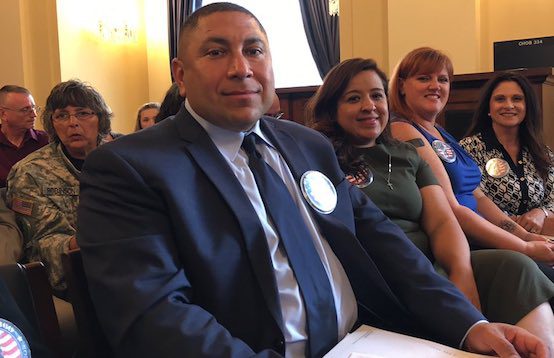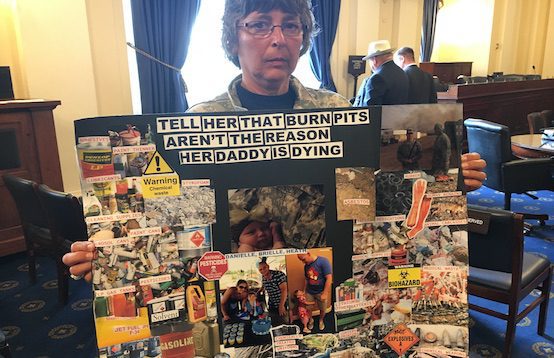Vets Cheer as VA, DoD Take a Beating at Burn Pits Hearing

The veterans were lined up, taking up four or five full rows, dressed in suits and skirts, their hands folded in their laps, faces unreadable. Some donned big buttons declaring their affiliation with Burn Pits 360, the first and largest advocacy group of its kind. Otherwise, they looked like any other audience in a Congressional hearing on Capitol Hill.
But they were waiting patiently, and when Rep. Raul Ruiz (D-Calif.) finished with his grilling of the Veterans Health Administration representative testifying before the House Veteran’ Affairs Health Subcommitee Thursday, the veterans (several with spouses), erupted into applause.
Someone at the back exclaimed, “Finally!”
There seems to be momentum now, after a dry spell of several years in which the chronic, sometimes fatal health conditions that veterans, doctors and scientists have connected to the open-air burn pits operating on the sprawling U.S. bases in Iraq and Afghanistan seemed all but ignored by official Washington.
Ruiz, who just launched a bipartisan Burn Pits Caucus in the House, used his five minutes on the panel to deliver a devastating remonstration of the government’s decade-long refusal to acknowledge the direct health connections to the burn pits. He pointed out what most of audience already knew: that the Pentagon was aware that the trash burning craters were toxic cesspools as early as 2006. Before finishing, he rounded on Ralph Erickson, the VA’s chief consultant for post-deployment health at the Office of Patient Care Services (note: the VA did not send anyone with any direct experience with burn pit injuries, although he was accompanied by a New Jersey VA doctor who remained silent during the entire hearing).
The government studies, Ruiz blasted, were going on for years with seemingly no definitive resolution in sight, while veterans who are suffering from cancer and debilitating lung disease—over a dozen reportedly dead already—cannot access VA healthcare or benefits because the government has not accepted that their symptoms are service-connected.
“You’ve got to act,” said Ruiz. “We need to give the veterans their benefits and educate the doctors right now.”
[youtube https://www.youtube.com/watch?v=z1jKDztSrq8&w=560&h=315]
The issue is gaining renewed traction in Congress today because a growing number of younger members in Congress are among the nation’s 3.4 million Iraq and Afghanistan War veterans, and either had direct experience with the burn pits or know fellow vets who are suffering. They are also pressed by constituents, who are now organizing. They are lobbied, too, by major service organizations like the Veterans of Foreign Wars (VFW) and Iraq and Afghanistan Veterans of America (IAVA). Both sent representatives to testify yesterday.
Rep. Brian Mast (R-Fla.) is a 37-year-old veteran who lost both legs from an IED in Afghanistan in 2010. He was able to testify to the toxic conditions on base while he was there. “What is absolutely disturbing to me is that the chemical attacks that we really needed to fear were the ones that were coming from within our own camps.”
To get an idea, the pit at Balad Air Base in Iraq, home to upwards of 30,000 people at its peak, used to burn 270 tons of garbage, including car parts, batteries, human waste—even body parts and jet fuel—a day.
Rep. Tulsi Gabbard, D-Hawaii, served in Iraq as a member of the Army National Guard in 2004. She and Mast recently introduced bipartisan legislation that would require the Department of Defense to record whether a service member was stationed near a burn pit during service, cross reference it with post-deployment health examinations, and place anyone with symptoms into the current Airborne Hazards and Open Air Pit Registry (there are over 143,000 individuals on it now). The bill also requires DoD and the VA to share information regarding affected vets’ health exams (something that isn’t happening now).
Gabbard, like Ruiz, balked at the number of studies that seem to go nowhere. She noted a woman in the audience whose husband is suffering from stage four cancer and is not eligible for caregiver benefits because “his illness is not being recognized as service connected, even though his job, his specific duty, was to tend to these burn pits directly” while overseas.

“We have a lot of people in this room and those who could not be here…who have tried over, and over, and over, and over again to their service connected and have been denied.”
“They wonder if they will be alive when these studies are complete.”
After Congress was able shut down the use of the pits in 2009 (though we know they were used in several places until 2013), the issue went off the radar, becoming a badge of concern for a handful of members while vets were forced to beat the marble halls every two years to bring a new batch of freshman up to speed. Gabbard and the others acknowledged the renewed interest, but, “it’s unfortunate that this remains such an obscure issue for many members of Congress.”
The DoD took the most hits at the hearing, having skipped it. Some speculated that a damning interview with a former Army inspector on Fox News that morning had given the Pentagon cold feet. In that interview, Lt. Col. Dan Brewer recalled a comprehensive environmental assessment he did for the DoD in 2005 which he said sounded the alarms about the danger to troops and possible liability for the military down the road (recall, this is three years before the military issued talking points saying the air conditions were largely harmless, and four years before the pits were shut down).
“I probably took 2,000 pictures when I was there,” Brewer said. “Medical waste, syringes, ammunition, weapons, classified information, (those were) the things that were in there. I found one burn pit (where) they were burning asbestos. That’s pretty bad, but the problem was, nobody had the training to know what to do.”
“I saw early on that this was going to be a problem for the health of our troops.”
He went back to the states in 2005 and delivered his findings to Central Command and said he was “stonewalled.” He filed numerous other reports but they gathered dust.
When veterans began reporting their illnesses back home and TAC started reporting this in 2009, the military was still in full-denial mode. It wasn’t until Congress stepped in that they shut down the pits and sent incinerators to the bases—but we know many stood there unused. A class action suit representing more than 800 sick veterans—including 12 who allegedly died from illnesses relating to the pits—is now before the Fourth Circuit Court of Appeals. It alleges that major government contractor Kellogg, Brown & Root failed to install and maintain incinerators and created an unsafe environment by burning the trash in unregulated pits. The company denies liability, saying it was following the government guidelines and is immune from suit.
The DoD did not return a request from TAC for comment for this story.
[youtube https://www.youtube.com/watch?v=t6TE0fLWOto&w=560&h=315]
For LeRoy Torres, 45, who is suffering from constrictive bronchiolitis (he was one of the few vets diagnosed by Dr. Robert Miller, a pioneer in the burn pits lung illness discovery before the Army stopped referring their soldiers to him), yesterday’s hearing was a boon. Torres and his wife Rosie started Burn Pits 360 after he fell ill in 2008, and have slogged through an often disappointing quest for recognition with fellow veterans ever since.
“We have better expectations now, with the support were seeing from Congress,” he told TAC after the hearing. “It’s what we’ve been waiting for for almost a decade. The wheels are turning at a much faster rate.”
For his part, Dr. Ralph Erickson, who testified on behalf of the VA Thursday, responded that some 9,000 vets have been granted service-connected benefits as a result of new policies that went into place eight years ago. He said the VA has been working with the DoD on no fewer than six studies gathering data from veterans that will help us “fully address the health related concerns of potentially affected veterans. There concerns are, of course, shared by the VA, DoD and Congress.”
Lauren Price, a U.S. Navy veteran who founded Veteran Warriors with her husband Jim to advocate on behalf of veterans in the VA healthcare bureaucracy, said no one is buying the endless cycle of studies and task forces any longer. She said the hearing at the very least exposed the ongoing weaknesses in the government’s position.
“Fortunately for those who are suffering from those exposures, most legislators are seeing the VA’s lack of response for what it is—round two of the decades-long stall tactic that the agency exhibited with Vietnam era veterans and their claims about Agent Orange.”
Kelley Beaucar Vlahos is the Executive Editor of The American Conservative.
Comments